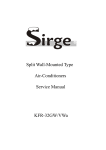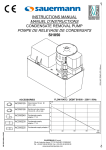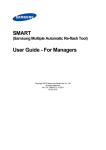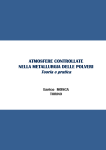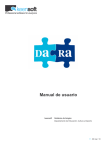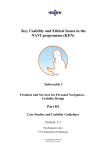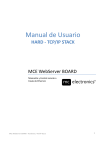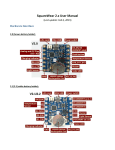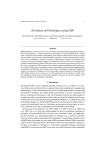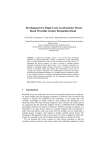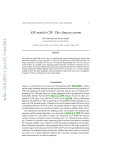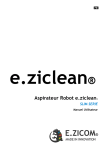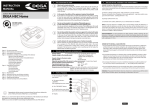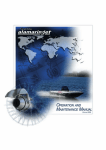Download Anil Puchchkayala_Thesis
Transcript
Wearable and Mobile Computing Support for Field Service Engineers – EL007A Anil Puchchkayala Abstract November 26, 2013 ABSTRACT Due to the rapid development in electronics and radio communication systems, modern technologies are implemented to improve the safety and security of workplaces in order to save field service engineers lives and their health. In this thesis, an automated safety suit was implemented with integrated sensors for monitoring the safety of field service engineers. The basic idea of the prototype is to ensure safety for the field service engineers who are working in adverse environmental conditions. This safety suit includes embedded devices which can communicate with mobile devices and by means of that provides aid for the people working in several fields such as confined spaces, high altitudes etc. In this prototype, a different type of sensors are proposed for monitoring environmental and health conditions like temperature, CO gas levels, relative humidity, body temperature and heartbeat. A mobile application is proposed to monitor and control the automated safety suit, which also identifies the environmental changes and provide prompt alerts to the user. Keeping the usage of automated safety suit in mind, the system is designed in a user friendly manner and all the key elements are considered and implemented accordingly for the requirements of service engineers who are working in confined spaces and hazardous places. Keywords: automated safety suit, wearable technologies, mobile computing, human safety, confined areas. i Wearable and Mobile Computing Support for Field Service Engineers – EL007A Anil Puchchkayala Acknowledgements November 26, 2013 ACKNOWLEDGEMENTS This thesis work is the result of 20 weeks of Research and Development project that has been carried out at the department of the Automation Technologies in the Software Architecture and Usability group (SARU), ABB Corporate Research in Vasteras, Sweden. It is working with the cooperation with school in Electronics Design, Mid Sweden University (MIUN). First of all, I would like to thank Marko Lehtola, my supervisor at ABB Corporate Research in providing his excellent guidance and support during the master thesis work and also I would like to Dr. Markus Aleksy, team leader for guiding my master thesis work. Special Thanks to Dr. Magnus Larsson, my manager and SARU team for warm, welcome environment and providing the many technical helps during my thesis. I would like to thank Dr. Benny Thornberg for his invaluable discussions, examining my thesis, comprehensive suggestions, and corrections to the final report. I would like to thank my beloved parents for their unconditional support and motivation during my studies. I had a great time working with my fellow thesis workers at ABB and I would like to thank them for providing me a friendly work environment, humorous discussions during our lunch and coffee breaks. Last but not least, I would like to thank my friends who were always encouraging and supporting to attain my goals. ii Wearable and Mobile Computing Support for Field Service Engineers – EL007A Anil Puchchkayala Preface November 26, 2013 PREFACE This report is about my thesis project carried out at ABB Corporate Research Centre, Vasteras from April 1st, 2012 to August 10th, 2012. This master thesis is also the last part of my education in the International Masters degree with the specialization in Electronics Design at Mid Sweden University, Sundsvall, Sweden. This project is within the design and development of electronic systems for wearable applications with the SARU Group at ABB Corporate Research, Vasteras. The focus of the team was to research and implement new wearable technology for industrial field service engineers. The tasks were challenging and we successfully developed a prototype system that has assisted me in understanding development of wearable system according to industrial field service engineers environment. Vasteras November 26, 2013 Anil Puchchkayala iii Wearable and Mobile Computing Support for Field Service Engineers – EL007A Anil Puchchkayala Table Of Contents November 26, 2013 Table Of Contents Abstract i Acknowledgements ii Preface iii Terminology / Notation vii 1 2 3 Introduction 1.1 Background and problem motivation . . . . . . . . . . . . . . 1.2 Overall aim . . . . . . . . . . . . . . . . . . . . . . . . . . . 1.3 Scope . . . . . . . . . . . . . . . . . . . . . . . . . . . . . . 1.4 Concrete and verifiable goals / (Low-level) Problem statement 1.5 Contribution . . . . . . . . . . . . . . . . . . . . . . . . . . . 1.6 Outline . . . . . . . . . . . . . . . . . . . . . . . . . . . . . 1.7 About ABB Corporate Research . . . . . . . . . . . . . . . . Introduction to Wearable Computing 2.1 Wearable technology . . . . . . . . . . . . . . . . 2.1.1 Wearable system . . . . . . . . . . . . . . 2.1.1.1 Energy source . . . . . . . . . . 2.1.1.2 Network architecture . . . . . . 2.1.1.3 Transducers . . . . . . . . . . . 2.1.1.4 Robust packing . . . . . . . . . 2.1.1.5 Wearability . . . . . . . . . . . . 2.1.1.6 User interface . . . . . . . . . . 2.2 Wearable applications . . . . . . . . . . . . . . . . 2.2.1 Wearable applications at workplaces . . . . 2.2.2 Wearable applications at medical and health Methodology 3.1 Analysis of the problem domain . . . . . . . . . 3.2 Wearable system Designing criteria . . . . . . . 3.3 System architecture . . . . . . . . . . . . . . . . 3.3.1 Wearable automated safety suit algorithm iv . . . . . . . . . . . . . . . . . . . . . . . . . . . . . . . . . . . . . . . . . . . . . . . . . . . . . . . . . . . . . . . . . . . . . . . . . . . . . . . . . . . . . . . . . . . . . . . . . . . . . . . . . . . . . . . . . . . . . . . . . . . . . . . . . . . . . . . . . . . . . . . . . . . . . . . . . . . . . . . . . . . . . . . 1 1 2 2 2 3 3 4 . . . . . . . . . . . 5 5 5 6 7 7 7 8 8 8 9 9 . . . . 11 11 11 12 14 Wearable and Mobile Computing Support for Field Service Engineers – EL007A Anil Puchchkayala 4 5 Table Of Contents November 26, 2013 Design and Implementation 4.1 Safety suit . . . . . . . . . . . . . . . . . . . . . . . . . 4.1.1 Sensors . . . . . . . . . . . . . . . . . . . . . . 4.1.2 Feedback devices . . . . . . . . . . . . . . . . . 4.1.3 Emergency panic button . . . . . . . . . . . . . 4.1.4 Electronics integration into automated safety suit 4.1.5 Working procedure of the safety suit . . . . . . . 4.2 Mobile application . . . . . . . . . . . . . . . . . . . . 4.2.1 Wearable advanced safety suit . . . . . . . . . . . . . . . . . . . . . . . . . . . . . . . . . . . . . . . . . . Results 5.1 Performance of the automated safety suit . . . . . . . . . . . . . 5.2 Comparision between Bluetooth, Zigbee and ANT technologies 5.3 Comparision between Wired and Wireless technologies . . . . . 5.4 Automated safety suit power analysis . . . . . . . . . . . . . . 5.4.1 Theoretical power analysis . . . . . . . . . . . . . . . . 5.4.1.1 Practical test results . . . . . . . . . . . . . . . . . . . . . . . . . . . . . . . . . . . . . . . . . . . . . . . . . . 15 15 15 17 18 18 20 21 21 . . . . . . 25 25 25 27 28 28 28 6 Discussion 31 7 Conclusions and Futurework 33 References 35 A Appendix1: User Manual 38 v Wearable and Mobile Computing Support for Field Service Engineers – EL007A Anil Puchchkayala List Of Figures November 26, 2013 List Of Figures 2.1 2.2 Basic wearable system. . . . . . . . . . . . . . . . . . . . . . . . . . Advanced wearable system. . . . . . . . . . . . . . . . . . . . . . . . 5 6 3.1 3.2 Overall architecture of the wearable automated safety suit monitoing system. . . . . . . . . . . . . . . . . . . . . . . . . . . . . . . . . . Wearable automated safety suit algorithm and data flow. . . . . . . . . 13 14 4.1 4.2 4.3 4.4 4.5 4.6 4.7 Sensor locations inside the safety suit. . . . . . . . . . . . . . . . The design of the automated safety suit. . . . . . . . . . . . . . . Communication between mobile phone and automated safety suit. WASS application class diagram. . . . . . . . . . . . . . . . . . . Android application login screen. . . . . . . . . . . . . . . . . . . Android main screen. . . . . . . . . . . . . . . . . . . . . . . . . WASS application settings screen. . . . . . . . . . . . . . . . . . 16 19 20 21 22 23 23 5.1 Left picture shows the advanced safety suit and right picture shows the Android application. . . . . . . . . . . . . . . . . . . . . . . . . Left picture shows the alert temperature notification and right picture shows the temperature alert message. . . . . . . . . . . . . . . . . . . Sensors data stored in server. . . . . . . . . . . . . . . . . . . . . . . 5.2 5.3 vi . . . . . . . . . . . . . . 26 26 30 Wearable and Mobile Computing Support for Field Service Engineers – EL007A Anil Puchchkayala Terminology / Notation November 26, 2013 TERMINOLOGY / NOTATION Acronyms / Abbreviations • BAN Body area network. • BPM Beats per minute. • BT Bluetooth device. • CO Carbon monoxide. • CPU Central processing unit. • E-textiles Electronic textiles. • GPS Global positioning system. • GUI Graphical user interface. • HCI Human computer interaction. • NIMH Nickel metal hydride. • OHA Open handset alliances. • PDA Personal digital assistance. • PPE Personal protective equipment and safety. • PPM Parts per million. • RF Radio frequency. • Rh Relative humidity. • SMS Short message services. • UI User interface. vii Wearable and Mobile Computing Support for Field Service Engineers – EL007A Anil Puchchkayala • USB Universal serial bus. • UUID Universally unique identifier. • WLAN Wireless local area network. • XML Extensible mark up language. • C Degrees of celsius. viii Terminology / Notation November 26, 2013 Wearable and Mobile Computing Support for Field Service Engineers – EL007A Anil Puchchkayala 1. Introduction November 26, 2013 I NTRODUCTION In early 1990s Mark Weiser had coined the phrase ubiquitous computing, which is a post desktop model of Human-Computer Interaction (HCI). Ubiquitous computing processes the information and has been thoroughly integrated into everyday objects and activities [16]. Ubiquitous computing employs many computational devices and systems which people can forget and interact with without actively thinking of them. Therefore, in order to make this computing approach in real time, development in the miniaturization of electronics and new types of specialized user interfaces for ubiquitous applications is needed. People are becoming accustomed to small and light electronic appliances such as mobile phones, Personal Digital Assistants (PDAs), Global Positioning System (GPS) devices etc. which indicates that the new technological equipment is well accepted by the market. Persons can easily carry these devices by embedding them in clothing accessories which are generally known as wearable electronics appliances [14]. Departments related to military, civil, and medical sciences are showing keen interest in research and development of an intelligent approach which addresses the required safety measures such as heartbeat, body temperature, environment temperature, and humidity levels. A wearable system composed of electronic and control components is implemented into a field service engineer’s wearable garment in order to meet the purpose. The main aim of this wearable system is to register field service engineer’s physiological parameters, environmental parameters, and to analyze these parameters continuously in order to know about sudden health state changes and accidental injury during their work. Emerging wireless communication technologies have make it possible to include embedded platform with desktop platform to control and monitor the system. Utilizing wireless communication devices such as PDAs and mobile phones makes it easier to communicate the sensor devices practically. Size reduction of electronic systems is one major issue in designing the prototype so that the wearable garment will be more comfortable to the end user. Thus, care must have taken to include sensors into the automated safety suit and to ensure the successful communication between automated safety suit and mobile devices. 1.1 Background and problem motivation In an estimation given by the international labor organization two million people die every year from work related accidents and diseases across the world [13]. For the sake of workers in industries such as factories and plants precautions are taken during work 1 Wearable and Mobile Computing Support for Field Service Engineers – EL007A Anil Puchchkayala 1. Introduction November 26, 2013 operations. Nearly 160 million people are diagnosed due to work related diseases and estimation of 270 million people are affected due to fatal and non-fatal work related accidents every year. It is important to make industrial workplaces safer and it is possible through wearable and mobile computing approach to prevent or reduce the accidents. Field service engineers often need to execute work orders in different kind of environments and some work orders requires special training and equipment. In an industrial working environment, service engineers may face several safety issues. Here, the usage of a wearable sensing and computing equipment can improve the safety standards. The proposed automated safety suit helps reducing safety-related risks by sensing users and environmental conditions. Therefore the automated safety suit ensures the safety of the field service engineers at work places. This safety suit provides physical alerts in their work area and mobile alerts to the service engineer, supervisor of the work field or control center whenever the sensors detect abnormal conditions. 1.2 Overall aim The main objective of this thesis is to develop a new generation of advanced protective clothing for the field service engineer that leads to a significant increase in field service engineer’s safety without reducing work performance. 1.3 Scope The scope of this thesis specially targets to monitor and act upon changed users and environmental related conditions for the field service engineer out in the field. 1.4 Concrete and verifiable goals / (Low-level) Problem statement In confined spaces of today the safety measures are monitored manually which can be very risky to the field service engineers lives. While doing the work in confined spaces, a person is set at the door to control the emergency situation usually based on a paper-based approach which is needed to document, what has happened during the emergency or abnormal situations. Thus, in order to avoid the human loss, automated safety suit is implemented in this thesis to increase the field service engineers safety. In this case the automated safety suit should be designed and implemented with minimal loss of data, low energy consumption and cost effective. 2 Wearable and Mobile Computing Support for Field Service Engineers – EL007A Anil Puchchkayala 1. Introduction November 26, 2013 • To design an automated safety suit for field service engineers using different sensors and actuators to monitor the environmental and health conditions at workplaces. • To compare wired BAN and wireless BAN communications and implement one of them that is flexible with wearable automated safety suit which means to capture the field service engineer sensors data more accurately. • To compare wireless technologies and implement suitable technology that is compatible with wearable automated safety suit which means to consume low energy that intern will provide longtivity of battery in safety suit during service. • To design a supervision application for reading the sensor data from the safety suit and to make the decision according to the situation. • Provide the early warnings to the field service engineer in case of any emergency situation in the working area and also send these warnings via SMS, email and make an automatic phone call to the supervisor. • Store the sensor data in the mobile application database in XML format and send it to the server. • Study and analyze the battery life time of the Wearable safety suit with an experiment test. 1.5 Contribution The proposal for this thesis work was put forward by the ABB Corporate Research as a part of the wearable application project within the SARU Group unit. In this thesis work, the automated safety suit and supervision application were developed by me, to ensure the safety of the field service engineers at working environments. The implementation, execution and evaluation part of this work was done by me with the help of Use cases provided by ABB Corporate Research. 1.6 Outline The whole report is structured into six chapters. In chapter 2, It starts with a brief overview and examples of the wearable technologies. In chapter 3 presents an analysis of the problem domain, and the proposed solution, system architecture is explained. In the next chapter 4 describes the design and implementation of the wearable system. In chapter 5, we have discussed the preliminary results of the wearable system. In chapter 6, we have concluded and outlined the future improvements in wearable system. 3 Wearable and Mobile Computing Support for Field Service Engineers – EL007A Anil Puchchkayala 1.7 1. Introduction November 26, 2013 About ABB Corporate Research ABB Corporate Research in Vasteras is one of the seven ABB research centers worldwide, with 300 employees, supporting the operating companies by furnishing them with fundamental research, new technologies and innovative solutions for future product generations. This thesis work was conducted at ABB Corporate research in Vasteras, in Software Architecture and Usability(SARU) group. 4 Wearable and Mobile Computing Support 2. Introduction to Wearable Computing for Field Service Engineers – EL007A November 26, 2013 Anil Puchchkayala I NTRODUCTION TO W EARABLE C OMPUTING 2.1 Wearable technology Wearable technology is defined as the intersection of the fields ubiquitous computing and functional clothing design [11]. However, the functional design process has to be made reliably into the design of wearable technology. Designers of wearable technology could easily understand the ways of human interaction with computing devices rather than human interaction with clothing. Consideration of both is essential for the successful design as they are highly dynamic and culturally influenced. Introduction of wearable technology to field service engineers where they are exposed to dangers or hazards could save their lives. Therefore, in that case a reliable wearable system has to be implemented. 2.1.1 Wearable system A set of heterogeneous modules is included in a wearable system wherein the most basic configuration consists of one input module, one main module and an output module as shown in Figure 2.1. Figure 2.1: Basic wearable system. In a wearable system, input module is basically a transducer that translates thermal, mechanical, electrical, chemical or radiant signal into an electrical signal. These transducers are also called as sensors. Some examples of input modules are camera, microphone, mouse and radio frequency (RF) transceiver. In order to monitor the system a transducer also comes under the output module, whereas transducers in the output module acts in a quite opposite direction in which an electrical signal is transformed into a mechanical, thermal, magnetic and chemical or radiant signal. Some of the examples of monitor modules are earphone, display, vibrating tactile, and RF mo5 Wearable and Mobile Computing Support 2. Introduction to Wearable Computing for Field Service Engineers – EL007A November 26, 2013 Anil Puchchkayala dem. A data processing module contains the processing power (digital signal processor, general purpose processor, and configurable hardware), storage memory (volatile and nonvolatile) and on board software (operating system, application software, and drivers). A fusion of different technological areas is made when designing a complex system such as wearable system in the garment. In order to meet the robustness, functionality and ergonomics, several areas are required to be advanced [26]. Some of the most important areas can be grouped and is depicted in Figure 2.2 and as follows. • Energy source • Network architecture • Transducers • Robust packaging • Wearability • User interface Figure 2.2: Advanced wearable system. 2.1.1.1 Energy source Energy is one of the primary limiting factors when designing a wearable system. The main source of energy in wearable system is the battery. Over the past decade capacity of batteries has increased but they are not being up to the mark with the increasing 6 Wearable and Mobile Computing Support 2. Introduction to Wearable Computing for Field Service Engineers – EL007A November 26, 2013 Anil Puchchkayala power demands of wearable systems. Batteries are categorized into two types which are primary and secondary. Primary batteries are used once and discarded after the life whereas secondary batteries are rechargeable batteries. In the aspect of wearable garment, secondary batteries are well suited for long term and in prospective of cost efficient and environmental aspects. In order to extend the limited capacity of batteries, power supply strategies have been introduced. These are summarized in three main categories which are low power design, power management, and power harvesting. Optimization of hardware architecture in order to reduce the power consumption comes under the low power design which mixes analogue and digital data processing units. In order to save power during inactivity, some parts of the hardware are turned off or switched to a low power state. 2.1.1.2 Network architecture A well developed network infrastructure based upon open communication standards is to be implemented on wearable systems. There are two different types of communication which are off body and on body communication. Wireless technologies are used for off body communication referred to as Wireless Local Area Networks (WLANs). In relation to on body communication, there are a couple of strategies that have been adapted: Wired and wireless communication such as Body Area Network (BAN) or Personal Area Network (PAN). Considering the better power management and higher bandwidth to power ratio, the wired solution is preferable than the wireless BANs/PANs for the human body in reference to the placement of sensors. IEEE 802.12.1(Bluetooth), IEEE 802.15.4 (Zigbee), IEEE 802.15.3 are some of the examples of wireless BANs/PANs. Ethernet, USB, Firewire, etc. are some of the examples of wired BANs/PANs [24]. 2.1.1.3 Transducers The functionality of a wearable computing solution can be enriched utilizing transducers. That way, monitoring functionality and context-awareness can be realized in wearable computing. Primary importance is given in this area for the development of future state-of-the-art wearable systems. Some of the parameters are considered in selecting the transducers for designing a wearable system. The system must be of low cost, flexible, low power, while still robust, washable or reusable[10]. Miniaturization is the key factor for building unobtrusive hardware in wearable system. Unobtrusive hardware with low power consumption, higher operating speeds and high ubiquity are made using nanotechnology in textile materials 2.1.1.4 Robust packing One of the primary considerations in designing a wearable system is robustness. Fragile designs are not acceptable as it they require a high degree of maintenance when it 7 Wearable and Mobile Computing Support 2. Introduction to Wearable Computing for Field Service Engineers – EL007A November 26, 2013 Anil Puchchkayala comes to wearable system. The electronic parts that are not well stress-relieved will eventually turns to system failure in a short period of time. Therefore, robustness is not only related to mechanical but also to electrical issues as well as to computer science issues. Electrostatic discharges and electronic magnetic fields should be immune to the system and as well as to coexist with neighboring systems and emitting peripherals. 2.1.1.5 Wearability Physical comfort and wearability are to be considered, when mounting wearable device on the body. The intended functionality counteract with poor design of an internal intelligent garment or wearable device. When designing a wearable device, several issues are to be considered. Mobility: Design of the wearable device should not interfere with natural movements and also should take into account situation specific movements. Weight of the wearable system should not interfere with stationary or dynamic balance when in more extreme conditions. Placing a weight close to the bodys center of gravity generally reduces the perception of weight [12]. Flexibility: There are two types of PCBs available to integrate into clothing or body, flexible and standard solid PCBs. Flexible PCBs come with optimal bend radii of 1-2 millimeter where as standard solid PCBs are often difficult to integrate. The problem with the flexible PCB is that it depends on the layout of the components it is populated with and will weaken electrical connection. 2.1.1.6 User interface The user interface enables the interaction between the user and the system and it is used to represent the information which is very easy to understand the results. In this thesis work, to develop user interfaces in wearable technology, the Android platform is used for displaying the data from various sensors. 2.2 Wearable applications The sensors are integrated with clothing or personal objects, to improve the capabilities proactively to develop systems from hazardous environments by using wearable computing. Wearable applications supervise the people in their daily life or by providing the assistances in work places. Moreover, these can also help people with the tools for coping with a range of tasks. There are few examples of integrated e-textile clothing applications. Wearable applications include more mobile computing equipments, portable music player, heart rate monitors, and wrist worn computers etc. These can be utilized while moving. So, these applications are usually used for hobbies and entertainment purpose. Several examples are discussed in the section below. 8 Wearable and Mobile Computing Support 2. Introduction to Wearable Computing for Field Service Engineers – EL007A November 26, 2013 Anil Puchchkayala 2.2.1 Wearable applications at workplaces Wearable electronics provide the benefits for the people in a wide range of work environments. These are supported in both mobile office and dangerous environments such as military, the rescue services as well as in space. However, most of the wearable applications are related to manufacturing, maintenance and inspection tasks [15]. For example in aircraft maintenance, repair, and inspection are also served. Wearable computer gives additional information as well in diagnosis, troubleshooting, and repair. Moreover, when the information is available through wearable systems, significant time saving can be achieved. Wearable computers have been proposed for warehousing and inventory control many years ago. Most of the industrial applications needs a comfortable wearable computer. This wearable computer needs to fulfill factors such as light weight, minimal cabling no heat generation, and uninterrupted setup which can be used for longer periods. Radiation, high temperatures, and air shortage in air tubes may be life threatening situations for fire fighters. By monitoring the environment for better communication and supervision between every single firefighter and head of the team there should be a smart clothing system, which sustains at high temperatures [17]. In disaster zones wearable computers are recommended to help rescuers such as providing assistance in locating team members and data collection. 2.2.2 Wearable applications at medical and health In the recent past health monitoring wearables are commercially available namely Bodymedia. This is designed with an armful of sensors for detection of heat flux, skin temperature, moment, near body temperature, and galvanic skin response. In another research in the University of Birminghams developed a wearable system named as Sensvest [20], which is used for monitoring the sports activity. A WEALTHY wearable health care system is a design of integrated sensors with the fabric of user clothes [22]. This wearable system helps in the monitoring of patients diagnosed with heart diseases. The University of Nottingham has developed a GRID [9]monitoring system that enables and displays the historical data, live data and, also performs data mining. The MIThril LiveNet system was developed at MIT for monitoring the health of soldiers. This wearable system includes embedded accelerometer and temperature sensors to detect shivering and avoid hypothermia in soldiers [21]. 9 Wearable and Mobile Computing Support 2. Introduction to Wearable Computing for Field Service Engineers – EL007A November 26, 2013 Anil Puchchkayala 10 Wearable and Mobile Computing Support for Field Service Engineers – EL007A Anil Puchchkayala 3. Methodology November 26, 2013 M ETHODOLOGY 3.1 Analysis of the problem domain The main research of this thesis work is focused on a monitoring system to support field service engineers at workplaces. The field service engineers usually face a wide range of hazards in industrial working environments. Now-a-days in workplaces services engineers are using different kind of equipments like safety gloves, hearing protection headsets, and helmets these equipments are not enough to self rescue the service engineer. The environment in which the service work is carried out varies from safe zone to hazardous. The service engineer working on-site may get unknowingly affected by a gas leakages or hazardous environmental conditions. Due to this reason they require special wearable equipment that can alert them in such situations. To solve this problem we proposed a wearable automated safety suit that can monitor the service engineers environmental and health conditions at workplaces. A wearable automated safety suit reduces the injuries and provides better protection from the accidents and enables data collection that can be used to analyze, and prevent future accidents. 3.2 Wearable system Designing criteria Before starting the design of the automated safety suit it is important to know the problems arise at the workplaces. In an investigation, The ABB company found the possible problems that arise in the workplaces. These investigations were done by the company people in industries. They identified several issues by conducting the interviews with service engineers. They made some use cases showing the problems that service engineers will meet in the workplaces: gas leakages , unexpected environmental conditions, technical failures, health problems. It is required that the automated safety suit can solve these problems. The proposed automated safety suit can solve the above problems with, 1. Monitoring the gas leakage at the workplaces. 2. Monitoring the service engineers environmental conditions and his own health conditions. 3. It provides the feedback alerts to the service engineer in case of emergency situation. 11 Wearable and Mobile Computing Support for Field Service Engineers – EL007A Anil Puchchkayala 3. Methodology November 26, 2013 4. If service engineer is not responding to the alerts the mobile application will send the alerts to the supervisor. In this prototype, the author used a high visibility vest based clothing system for designing the automated safety suit. It contains a body temperature sensor, pulse sensor, environmental temperature & humidity sensor, and a CO gas sensor. The body temperature sensor measures body temperature of the field service engineer’s, pulse sensor measures the heartbeat of the field service engineer’s, a CO gas sensor measures the CO gas and air temperature and humidity sensor measures the humidity and air temperature levels in working environments. The safety suit also contains a vibration motor and speaker. The speaker and vibration motor are used for giving the notifications when the dangerous sensor thresholds are exceeded. There is a need for data exchange between the safety suit and the mobile device. It can be achieved by using different kind of wireless technologies such as Bluetooth, Zigbee, Wlan. In this prototype, Bluetooth technology is used for communication between the safety suit and the mobile device. It is preferred because it provides high data rates and robust communication for short range distances. The important part of the system design is to make sure that the device and sensors are invisible to the user and stored inside the service engineers suit. 3.3 System architecture The advanced safety suit, as depicted in Figure 3.1, consists of five major components, namely the safety suit (SU), the mobile device(MD), the command central (CS), the supervisor, the communication. Safety suit: The automated safety suit is a wearable garment used for monitoring the users and environmental conditions such as CO gas levels, temperature and humidity levels etc.... The safety suit consists of several sensors and actuators. Moreover, it has a central processing unit (CPU) for transmitting and receiving sensors data to the mobile device via Bluetooth. Mobile device: The major principle of the mobile device is used to gather the entire sensor data from the safety suit. Finally, the mobile device is responsible for detecting abnormal conditions and provides immediate warning to the users. Command center: The command center is used to store the real-time multi sensor data coming from the mobile device. The received information is stored in the database for a long-term and it can be used for preventing the potential life-threatening. 12 Wearable and Mobile Computing Support for Field Service Engineers – EL007A Anil Puchchkayala 3. Methodology November 26, 2013 Supervisor: The supervisor plays key role in managing the field service engineers and providing the tasks at work locations. In case of any emergency situations supervisor is responsible. Communication: For shorter distance Bluetooth communication is used and for long-range distance mobile network 3G/GPRS can be used. The complete wearable system consists of two major components. The first one is the automated safety suit. It contains the several sensors and actuators integrated inside the safety suit. All the components are connected to the central processing unit (CPU) by using conductive material. The BAN protocol is used for collecting the data from the sensors and Bluetooth modules is used for transmitting the data to the second component-a mobile device. The latter is used to organize the sensor data and take the decision according to the user specifications. To be able to do so, a supervising application was developed. The mobile application was initially set up with predefined sensor thresholds, emergency contact number and e-mail address of the supervisor. These parameters can be adjusted by the field service engineer’s before going to execute the work order on the site. The mobile application stores the sensor data in XML format into the local database. The retrieved information can be useful for further processing. Therefore, the mobile application can send the automated messages with the coordinates of the user location to supervisor and command central whenever the dangerous sensor levels are detected. The system architecture is depicted in Figure 3.1. Figure 3.1: Overall architecture of the wearable automated safety suit monitoing system. 13 Wearable and Mobile Computing Support for Field Service Engineers – EL007A Anil Puchchkayala 3.3.1 3. Methodology November 26, 2013 Wearable automated safety suit algorithm The figure 3.2 shows the wearable system signal processing, algorithm and data flow. The automated safety suit collects the data from various sensors and it will send to the mobile application using a Bluetooth device. The mobile application takes the input sensor data from the safety suit and it will make the decision according to the sensor thresholds. In case of any emergency situation the mobile application will give the alerts to the user by means of audio and vibration alerts. If the user is not responding to these alerts the application will send the notifications to the supervisor with user location coordinates so that user can get the help from the supervisor. Figure 3.2: Wearable automated safety suit algorithm and data flow. 14 Wearable and Mobile Computing Support for Field Service Engineers – EL007A Anil Puchchkayala 4. Design and Implementation November 26, 2013 D ESIGN AND I MPLEMENTATION The automated safety suit was designed and the usability tests are performed at ABB Corporate Research Center. Prototype implementations are explained further in section 4.1. The prototype is based on wearable & mobile technologies and active clothing system. The prototype contains two major parts which are automated safety suit design and mobile application design. These parts are explained in the following sections. 4.1 Safety suit The automated safety suit contains different sensors for monitoring user’s and environmental conditions. This suit is equipped with actuators, such as speaker and vibrator to provide notifications when undesirable or dangerous sensor thresholds are exceeded. In this prototype, E-textile technology is used for integrating the sensor and microcontroller inside the safety suit. E-textile is an electronic textile that has the electronics and interconnections. It is used for both complex and protective sensing. The Arduino LilyPad microcontroller is used for collecting the data from the sensors. Arduino LilyPad is an open-source hardware toolkit and is specially designed for wearables and E-textiles. Inside the safety suit all these sensors are connected by using silver plated nylon 234/34*4ply thread. This is conductive material and it has low resistance for every 30 centimeters of the thread and the resistance loss is 14 ohms [5]. This thread carries the current and power signals. The firefly Bluetooth device is used for communication between the LilyPad microcontroller and mobile phone. The Bluetooth device sends the sensor data from the suit to mobile phone. 4.1.1 Sensors Sensors are playing critical role in developing the automated safety suit for monitoring the field service engineers health and environmental conditions. In this thesis some of the parameters are mainly considered according to the use cases. These use cases are conducted by the ABB Corporate Research center. Some of the parameters are explained below. Selection of the sensors When developing a wearable automated safety suit, while choosing the sensors 15 Wearable and Mobile Computing Support for Field Service Engineers – EL007A Anil Puchchkayala 4. Design and Implementation November 26, 2013 Figure 4.1: Sensor locations inside the safety suit. special attention must be taken regarding the size and its position on the body . The sensors should not obstruct the wearer, while daily activities are carried out. For this prototype the author has chosen appropriate sensors based on the sensitivity, low power consideration, and robustness [27]. Heartbeat The heartbeat sensor is used for finding the heart rate of the users. It is the biggest factor in the ability of the medical officials see the signs of distress. Low and high heart rates for a long time causes the cardiovascular health [25]. Photoplethysmography is one of the methods for calculating the pulse measurement. The pulse rate is defined by arterial blood oxygenate, measuring light absorption by blood [7]. A pulse sensor, which is an open source heart rate sensor is used for calculating heart rate of the service engineers in beats per minute. The pulse sensor is attached to the service engineer’s ear lobe and the other end is connected to the microcontroller. The microcontroller transmits the heart rate to the mobile phone by using bluetooth interface [25]. Body temperature A sudden change of the body temperature indicates infection [7] and stress. Human body temperature is rather different especially within the outer and inner parts of the body. A general body temperature is measured in the anus which is about 37.1 C. Temperatures are almost invariable for a healthy person and it varies depends upon the age and deviate about 0.4C to the general body temperature. It serves as an indicator 16 Wearable and Mobile Computing Support for Field Service Engineers – EL007A Anil Puchchkayala 4. Design and Implementation November 26, 2013 of the impeding infections and general stability of the persons. Body temperature is measured by using the electrical and optical devices. In this thesis TMP36 temperature sensor [6] is used which is very small and easy to integrate in the clothes. The temperature sensor is located on the chest and it is interfaced to the microcontroller. Carbon monoxide Carbon monoxide (CO) is one of the primary toxic gases in industrial environments. CO is colorless, odorless and tasteless gas and also it is not significantly detected by human senses [19]. In some cases, people are dying when they are working in the industrial fields such as in confined spaces, mines, and at high altitudes. It is extremely dangerous when people dont realize its existence [19] and may suffer with dizziness and headache. One of the gas sensors FAGARO TGS 370 is used for detecting the CO gas levels. It consumes the least power and gives more reliable, accurate data. The CO sensor reads the gas levels which are measured in parts per million (PPM) and transmits the data to the service engineer mobile using Bluetooth via microcontroller. The sensor is located to service engineer suit near to the chest location. Environment temperature and humidity sensor Temperature is one of the complex issues in industrial working area as it will create thermal discomfort to the user and it is harmful to the person. A hot working environment creates discomfort to the workers health, efficiency, and performance and also it will affect the workers heart rate, lower body temperature, and high sweat rate /citeoutertemp. High humidity with a longer period of time makes the problem worse under these conditions. Therefore, it is hard to perform work orders in these harsh working environments. Several types of sensors are available for measuring the environmental temperature and humidity values. In this thesis, SHT15 [3] sensor is used since it is fully calibrated and also the quality and accuracy of the sensor is high. The sensor is integrated into the workers safety suit and connected via microcontroller by using conductive thread. 4.1.2 Feedback devices Feedback devices are playing major role in wearable applications. They provide the physical alerts to the user when abnormal conditions are detected. In this prototype the author used speaker and vibrator for giving the notifications to the field service engineer. The speaker is located on the chest and the vibrator is located on the hip. 17 Wearable and Mobile Computing Support for Field Service Engineers – EL007A Anil Puchchkayala 4.1.3 4. Design and Implementation November 26, 2013 Emergency panic button The additional feature in this prototype is an emergency panic button. It is integrated into an automated safety vest and located in right hand shoulder position. The functionality of the emergency panic button is to send an alert signal to the workers mobile phone by pressing the button when the worker is in danger situation or any minor health problems. The mobile application will make a phone call and / or send an email or SMS to the supervisor of the field worker. Moreover, the mobile application is responsible for updating the command center and sending sensor data to a server. 4.1.4 Electronics integration into automated safety suit Arduino LilyPad is an open-source hardware toolkit which is used for integrating sensors inside the worker garment. Arduino LilyPad is a cost effective microcontroller and can easily be integrated inside the clothes. It is specially designed for wearable applications where it is responsible for monitoring the sensors inside the worker garment and collecting their data. Arduino LilyPad hardware contains Atmega 328 microcontroller. Arduino LilyPad controls the sensors used for the automated safety suit and it uses serial communication to transfer the data to the mobile phone with baud rate of 115200. It contains a multitude of analog and digital inputs and outputs. Technical specifications of Atmega 328 microcontroller are described below [1]. • 16k Flash memory • 1k SRAM for program memory • 6 Analog to digital converter pins • 14 Digital pins (6 PWM pins) • 8 MHz microcontroller • 512 bytes of EEROM • Operating voltage 2.5v to 5.5v • DC Current per I/O Pin40 mA • Open source programming • UART and SPI interfaces The Lily Pad microcontroller is placed on the worker’s safety vest near to the hip. The program for LilyPad is written in C programming language. The microcontroller uses 5V power supply and the battery holder is connected to the microcontroller with 18 Wearable and Mobile Computing Support for Field Service Engineers – EL007A Anil Puchchkayala 4. Design and Implementation November 26, 2013 conductive thread. Battery holder uses single 1.2 AAA batteries to power up the microcontroller. The battery holder is having an inbuilt regulator to regulate the power supply. Sensors and actuators are connected to microcontroller by using the conductive thread. The design of the automated safety suit is shown in Figure 4.2 . Figure 4.2: The design of the automated safety suit. In this prototype, BAN protocol is used for connecting the sensors inside the safety suit. BAN is a body area network which is divided into the two categories such as wired and wireless [23]. Wired BAN transfers the data between the sensors and microcontroller using the conductive threads and the power is distributed in the same thread. Bluetooth radio is one of the important components in automated safety suit design which will transmit the data from the suit to the mobile device. The firefly Bluetooth device is used in this prototype and it is connected to the microcontroller via serial interface. The Amarino tool kit is used for transferring the data from the suit to the mobile phone via Bluetooth. Amarino is a tool kit that provides two primary components which are Android application and Arduino library. Amarino creates the communication channel between the mobile phone and the microcontroller for sending and receiving the data via Bluetooth between the phone and microcontroller. Arduino library has a callback mechanism for incoming events. A developer registers one callback function for each expected event type and Arduino library will call the register function once an event has been received and then developer receives convenient functions to extract the data attached to the event [18]. 19 Wearable and Mobile Computing Support for Field Service Engineers – EL007A Anil Puchchkayala 4. Design and Implementation November 26, 2013 Figure 4.3: Communication between mobile phone and automated safety suit. The Meet Android library is used in the Arduino programming and this library provides convenient functions to develop programs for Arduino to send and receive data using Amarino communication channels. Bluetooth RSSI is an android application. It is used to manage Bluetooth connections to create events. These are to be sent to the Arduino device and monitor the sensor data. 4.1.5 Working procedure of the safety suit When the sensors detect any abnormal situation then the safety suit is switched into the automatic mode and it will send the SMS and e-mail automatically. Prior to sending a message, the safety suit notifies the worker by means of an audio signal with a vibration alert. Without any interaction from the user, the message will send within a predefined time. This time can also be changed by the worker in his mobile application settings. The worker should give the related response of the popped message in relation to the hazardous condition. If the worker does not respond to this message then the mobile application will send the message to the supervisor of the work field which includes coordinates of the worker’s location and sensor data which in turn indicates either an injury or a technical failure. 20 Wearable and Mobile Computing Support for Field Service Engineers – EL007A Anil Puchchkayala 4.2 4. Design and Implementation November 26, 2013 Mobile application The purpose of the Android application is to collect sensor data and display alerts and notifications on a mobile phone when it goes to abnormal conditions. It application is presented in a simple and easy to use interface. This application allows the user to monitor their vital signs and sensor data in a graphical manner. The Android application allows the supervisor of the work field or command center to view the vital signs of the field service engineer engaged in action. This application will send the automatic SMS, E-mails to the supervisor of the work field with the details of the user location and type of alert is raised in that situation. When the conditions are critical the application will make a phone call to the supervisor so that they could be alerted. 4.2.1 Wearable advanced safety suit The wearable advanced safety suit (WASS) is an Android application running on smartphone that gathers vital signs such as heartbeat, skin temperature, and outer environmental temperature and CO gas from the external safety suit. The author selected Android operating system for development of user interface which is open source and supports multi-tasking as well as background services. WASS is able to process the incoming sensor data and display it on the user interface. Figure 4.4: WASS application class diagram. 21 Wearable and Mobile Computing Support for Field Service Engineers – EL007A Anil Puchchkayala 4. Design and Implementation November 26, 2013 WASS contains three activities such as Loginaccess activity, AbbWearable activity and Graphview activity which is implemented in this application. The classes are shown in the WASS application class diagram Figure 4.4. WASS starts with a login screen which enables user to enter his credentials. WASS login screen is depicted in Figure 4.5. Figure 4.5: Android application login screen. Loginaccess is a class which extends activity in Android. This activity contains GUI components like relative layout, text views, edit texts, and buttons which are initialized from this class. GUI components are layouts which are loaded from an XML file in the resource folder. This class is used to access the resources from anywhere in the application. Figure 4.6 shows the main screen of the Android application after login. AbbWearable activity is the main class of the Android application and it contains GUI components such as layouts, text view, and buttons. In this activity the Bluetooth UUID is initialized for connecting to the safety suit. ArduinoReciver is the subclass in AbbWearable activity it extends to the BroadcastReciver class. It reads the sensor data from the Bluetooth port when the data are available and it will split the data and display to the user. Android activity contains the optional menu and it is having four submenus such as settings, export local, graph, and exit. From the setting button, the user is able to adjust the emergency contact, change the e-mail address, and set various sensor thresholds according to the user preferences which are shown in the Figure 4.7. After setting the thresholds in the settings screen, the application automatically 22 Wearable and Mobile Computing Support for Field Service Engineers – EL007A Anil Puchchkayala 4. Design and Implementation November 26, 2013 Figure 4.6: Android main screen. Figure 4.7: WASS application settings screen. 23 Wearable and Mobile Computing Support for Field Service Engineers – EL007A Anil Puchchkayala 4. Design and Implementation November 26, 2013 comes back to the main screen. In the main screen user can able to see the real time data coming from the safety suit via Bluetooth. The second tab export local is used for storing the sensor data into the local database in the XML format which is very useful to document when accidents occur and also to prevent the accidents in future. Storing the sensor data into the local database avoids a lot of paper work. The third tab Graph activity is used for displaying the body temperature and environment temperature in a graphical manner. The data from the automated safety suit is sent to the mobile phone which in turn sends all the information to the server to store the information on the web since server acts as a backend command central. Figure 5.3 shows the information from the various sensors which are stored in the server database. 24 Wearable and Mobile Computing Support for Field Service Engineers – EL007A Anil Puchchkayala 5. Results November 26, 2013 R ESULTS 5.1 Performance of the automated safety suit The functionality of the automated safety suit was verified at indoors in ABB Corporate Research center. Each and every sensor is tested alone before whole system was tested. During the period of testing, the performance of the automated safety suit was observed. The observed test includes situations sending an emergency message to supervisor, e.g. high environmental temperature. The components in the safety suit are well balanced and finally the appearance of the suit was like ordinary suit. To verify the automated safety suit we have tested with one person inside and outside the lab environment. For testing the safety suit , we had set the specific sensor thresholds in mobile according to the user requirements. From the safety suit, we got the some test results but still these are preliminary results only. In the Figure 5.1, the left side shows the advanced safety suit and the right side of the figure represents the mobile application of the wearable advanced safety suit in real time. The acquired sensors data were read out in mobile application which shows worker heart rate, skin temperature and environment temperature, humidity and CO gas levels. In the following Figure 5.2 the left side shows notifications and right side of the figure shows alert sign when a worker is in the undesired environmental condition. The result shows that the prototype developed was well suited for the field workers in determining their health and environmental conditions. The washing test of the safety suit was not performed in this thesis work. The sensors which are used in this safety suit are washable modules except heart beat sensor and Bluetooth modules. Due to this, before going to perform the washing test it is mandatory to remove the heart beat sensor and Bluetooth modules in the automated safety suit. 5.2 Comparision between Bluetooth, Zigbee and ANT technologies Table 5.1 shows the major properties of Bluetooth,Zigbee and ANT. All The above protocols are widely used for low power applications. ANT also has similler properties as the Bluetooth but at present it supporting only few mobile devices, where as Bluetooth can support for all the mobiles. By comparing all the above protocols Bluetooth has the less power consumption , high datarate transfer than Zigbee and 25 Wearable and Mobile Computing Support for Field Service Engineers – EL007A Anil Puchchkayala 5. Results November 26, 2013 Figure 5.1: Left picture shows the advanced safety suit and right picture shows the Android application. Figure 5.2: Left picture shows the alert temperature notification and right picture shows the temperature alert message. 26 Wearable and Mobile Computing Support for Field Service Engineers – EL007A Anil Puchchkayala 5. Results November 26, 2013 ANT. Property Frequency Range Datarate Peak current Consumption Latency Support for mobile device Bluetooth 2.4GHz 100m 1-3 Mbit/s 30 mA 100ms Yes ZigBee 2.4GHz 100-300m 100-250kbps 30-40mA 20ms Yes ANT 2.4GHz 10m 20kbps 17mA Zero Only few mobiles have support Table 5.1: Comparision between Bluetooth [2], zigbee and ANT technologies [4] 5.3 Comparision between Wired and Wireless technologies BAN is body area network. It is used for interconnecting the sensors inside the safety suit. There are two types of bans are available wired and wireless. Property Wired BAN Energy Consumption Low Data Rates The speed depends on length of the smart fabric. Interference There is no interference because in this case we are using only one device and remaining sensors are connected by using connective thread Node placement Is critical in wired BAN Battery Replacement very easy Wireless BAN Too high Too high More interference will occur because of multiple wireless sensor nodes. We can easily place new node in Wireless BAN It is difficult to change the batteries in every node Table 5.2: Comparision between wired Vs Wireless [8] The above Table shows the different properties of wired and wireless BAN. Both wireless and wired BAN have advantages and disadvantages. Depending upon particular application we opt for either wired and wireless BAN. Particularly for intra 27 Wearable and Mobile Computing Support for Field Service Engineers – EL007A Anil Puchchkayala 5. Results November 26, 2013 BAN communication wired BAN is better than wireless . Considering present project application,there are several reasons why wired communication is opted; one is that the energy consumption of a system is low in wired since it is communicating end to end whereas in wireless each and every node has to transmit and receive data that involves consumption of more power. This inturn lead to bigger size of a sytem with Bluetooth and Zigbee devices where it is not acceptable for BAN and more over replacement of battery becomes complex. There is more possibility for optimizing the sensor network usage given single layer hop toplogy with no interference under wired but in wireless it is quite opposite that is multi layer hop topology that results with more intereference. 5.4 5.4.1 Automated safety suit power analysis Theoretical power analysis The automated safety suit is powered by 1.2 v AAA rechargeable nickelmetal hydride battery. The below table shows the power consumptions of the each and every component in the wearable automated safety suit. The automated safety suit consumes 244.2 mA power which gives the theoretically four hours usage of with 1000mAh nickel metal hydride battery and also, we performed a practical test by wearing the safety suit. The practical test performed with four different rechargeable batteries, the test results are shown in the result chapter. The safety suit works up to four hours after that the mobile application will show the notifications to the user so that the service engineers can be able to replace the battery. Part Bluetooth Modem Body Temperature Sensor Environment Temperature and Humidity Sensor CO Gas Sensor Vibrator Speaker Avg.Power(mW) 0.025 0.825 0.00003 38 0 0 Peak.Power(mW) 153 0.825 1.8 120 63 98 Table 5.3: Theoretical power analysis 5.4.1.1 Practical test results In the below table shows the power consumption of the wearable safety suit. The power test was performed with four different rechargeable batteries. Table 5.4 shows battery life during practical tests and expected values. There has been voltage drop as 28 Wearable and Mobile Computing Support for Field Service Engineers – EL007A Anil Puchchkayala 5. Results November 26, 2013 we observe in the table. The reason behind is that the safety suit was designed with the silver conductive thread where it has the internal resistance of 30 ohms for every 30cm of the conductive thread. It is used for carrying current for power and signals that connects electronics on to clothing. The conductive thread length varies with placement of sensor and actuator. This might be the primary reason for the voltage drop of a battery as conductive thread was connected to different sensors and actuators across the whole wearable safety suit. Battery Test 1 Test 2 Test 3 Test 4 Battery Life (Practical result) 3 h 40 min 3 h 35 min 3 h 48 min 3 h 48 min Battery Life (Expected result) 4 hours 4 hours 4 hours 4 hours Table 5.4: Practical test results 29 Wearable and Mobile Computing Support for Field Service Engineers – EL007A Anil Puchchkayala Figure 5.3: Sensors data stored in server. 30 5. Results November 26, 2013 Wearable and Mobile Computing Support for Field Service Engineers – EL007A Anil Puchchkayala 6. Discussion November 26, 2013 D ISCUSSION Wearable and mobile computing technologies are providing more advantages to the field service engineers in the work areas. In the present thesis we developed a wearable automated safety suit for monitoring the field service engineers activities in the work fields. It is mainly developed for the field service engineers for detecting the hazardous conditions in the work environment. In the present prototype we selected a different kind of sensor for monitoring the worker environment and health conditions. The sensors are selected according to the safety suit specification based upon the requirements. Presently there are different technologies are available for communicating the safety suit and mobile device. Bluetooth, ANT and ZIGBEE technologies are providing more advantages in wearable computing. In the present prototype we have selected Bluetooth communication because It provides high data rates and the power consumption is low. It consumes less energy compared to the other technologies. The goal of this work was to design a wearable safety suit and mobile application for monitoring the field service engineers health and environmental conditions in the working area. The safety suit provides the early warnings to the service engineer and send these alerts to the supervisor in case of any emergency occurred in the field was presented. In future we are going to add more functionalities to the wearable safety suit like; finding the nearest exit point in the field in case of emergency and sending emergency alerts to the nearest possible person in the work area. In realistic the worker has to be on site for 8 hours in a day and as we can see that the battery was used on an average of 3hours 40 minutes with 1.2V rechargeable battery at 1000mAh. So the worker should have to replace the battery every 4hours approximately. This might be quite disappointment for a field worker. So there is in need for modification in power circuit module in the micro controller where for example with 4.5V non round battery with typical capacity of 6100mAh can be placed that could work for 3 days approximately. 31 Wearable and Mobile Computing Support for Field Service Engineers – EL007A Anil Puchchkayala 32 6. Discussion November 26, 2013 Wearable and Mobile Computing Support for Field Service Engineers – EL007A Anil Puchchkayala 7. Conclusions and Futurework November 26, 2013 C ONCLUSIONS AND F UTUREWORK In this thesis work a complete prototype of a wearable system was demonstrated and developed for monitoring and controlling field service engineers health. The proposed system is a low cost automated safety suit which is able to monitor the user conditions and send alerts to the supervisor of the work field as well as to the backend command central via e-mail, SMS, and phone call. The advanced safety suit was implemented and tested to provide all the measured sensor data. This data is tracked with a help of a wireless system to avoid the risk of human lives in confined spaces. In the present automated safety suit, sensors which are connected to the microcontroller through conductive thread has high resistance. To overcome this problem, in future an approach can be tried i.e, by twinning the two threads, the resistance can be decreased so that the sensors could be more easily distributed throughout the safety suit. The sensors such as body temperature sensor can be placed foldable at neck or integrated with heart beat sensor is one example of the above discussed approach. This automated safety suit has only four hours battery life and in future the battery life can be increased to eight hours which makes the automated safety suit more efficient for the workers in confined spaces. This android application sends alerts only to the supervisor of the field worker. However, the prototype can be extended in future to handle alerts to the technicians who are in close range of the work field to avoid problematic situations. 33 Wearable and Mobile Computing Support for Field Service Engineers – EL007A Anil Puchchkayala 34 7. Conclusions and Futurework November 26, 2013 Wearable and Mobile Computing Support for Field Service Engineers – EL007A Anil Puchchkayala REFERENCES November 26, 2013 REFERENCES [1]Arduino(2012). URL = http://www.arduino.cc/en/Main/ArduinoBoardLilyPad. Accessed April 11, 2012.18 [2]Power consumption analysis of bluetooth low energy, zigbee and ant sensor nodes in a cyclic sleep scenario. http://www.csr.com/sites/ default/files/white-papers/comparisons_between_low_ power_wireless_technologies.pdf. Accessed April 28, 2012.27 [3]Sensirion(2012), Digital Humidity and Temperature Sensor Doc. URL = http://www.sensirion.com/en/products/humidity-temperature/humidity-sensorsht11/. Accessed June 14, 2012.17 [4]Sparkfun electronics, ”Bluetooth Gold Mate”. URL https://www.sparkfun.com/products/9358. Accessed April 11, 2012.27 = [5]Sparkfun electronics, ”Conductive Thread - 234/34 4ply”. URL = https://www.sparkfun.com/products/8549? Accessed April 11, 2012.15 [6]Sparkfun electronics, ”TMP36 Temperature Sensor”. URL https://www.sparkfun.com/products/10988. Accessed April 11, 2012.17 = [7]J. D AUNORAS A.D OSINAS , M. VAITAKUNAS. Measurement of human physiological parameters in the system of active clothing and wearable technologies. Medicine Technology, 71:1392–1215, 2006.16 [8]P EDRO B RANDAO. Abstracting information on body area networks. Technical report, University of Cambridge, Computer Laboratory, 2012.27 [9]S UMNER , M. BARRATT, C. PALETHORPE , B. G REENHALGH , C. S TORZ , O. F RIDAY, A. H UMBLE , J. S ETCHELL , C. R ANDELL , C. M ULLER , H. C ROWE , J., H AYES -G ILL , B. Modular sensor architecture for unobtrusive routine clinical diagnosis. In: International Workshop on Smart Applicances and Wearable Computing, 2004.9 [10]S. S CARMAGNANI , J. H AYES D. D IAMOND ,, S. C OTLE ,. Wireless sensor network and chemo-/biosensing. Chem. Rev., 2008.7 35 Wearable and Mobile Computing Support for Field Service Engineers – EL007A Anil Puchchkayala REFERENCES November 26, 2013 [11] L UCY E.D UNNE. The Design of Wearable Technology: Addressing the HumanDevice Interface Through Functional Apparel Design. Master’s thesis, Cornell University, New York, United States, 2010. 5 [12] S TIVORIC ,J. BAUER ,M. & M ARTIN ,R. G EMPERLE ,F., K ASABACH ,C. Design for wearability. Paper presented at the 2nd International Symposium on Wearable Computers, 1998. 8 [13] L INDEN BALL , J ERRY B USBY, N IGEL DAVIES , C HRISTOS E FSTRATIOU , J OE F INNEY, M ARIAN I SZATT W HITE K ATHARINA K INDER G ERD KORTUEM ,, DAVID A LFORD ,. Sensor networks or smarat artifacts? an exploration of organization issues of an industrial ealth and safety monitoring system. UbiComp, 2007. 1 [14] JAANA H ANNIKAINEN. Electronic Intelligence Development Lomonosov’s for wearable Applications. PhD thesis, Tampere University of Technology, Institute of Electronics, 2006. 1 [15] M. BAUER J. S IEGEL ,. A field usability evaluation of a wearable system. First IEEE International Symposium on Wearable Computers (ISWC ’97) ,Cambridge, MA,USA, 1997. 9 [16] P.C. P ENDHARKAR J. YORK. Humancomputer interaction issues in mobile computing in a variable work context. Int. J. Human-Computer Studies 60., 2004. 1 [17] H ONKALA , M. P ELTONEN , P. M ATTILA , H. C LUITMANS , L. M ATTILA , J. VAATANEN , A. C OMERT, A. H YTTINEN , J. H ANNIKAINEN , J. T IERANTA , T. VANHALA , J. P IIPPONEN , K. S EPPONEN , R. K ARKI ,S., L EKKALA , J. Smart clothing for firefighters. International Scientific Conference of Intelligent Ambience and Well-Being (Ambience 05),pp. 221-229, Tampere,Finland, 2005. 9 [18] B ONIFAZ K AUFMANN. Design and Implementation of a Toolkit for the Rapid Prototyping of Mobile Ubiquitous Computing. Master’s thesis, University of Klagenfurt, Austria, 2010. 19 [19] M.B. M OHD KHADRI. Gas Mixure (Toxic gas) sensors by using sensor array. Master’s thesis, University Teknikal Malaysia Melakai, Malaysia, 2007. 17 [20] P SOMADELIS , F. BABER , C. B RISTOW, W. A RVANITIS , N. K NIGHT, F., S CHWIRTZ , A. The design of the sensvest. Personal and Ubiquitous Computing,pp. 16-19, 2005. 9 [21] S. J IMENEZ , J. G IPS , A, P ENTLAND M. S UNG ,, R. D E VAUL ,. Shiver motion and core body temperature classification for wearable soldier health monitoring system. in Proceeding of the 2004 IEEE International Symposium on Wearable Computers, 2004. 9 36 Wearable and Mobile Computing Support for Field Service Engineers – EL007A Anil Puchchkayala REFERENCES November 26, 2013 [22]T ACCINI , N. PARADISO ,R., L ORIGA , G. Wearable health care system for vital signs monitoring. Mediterraneam Conference on Medical and Biological Engineering, 2004.9 [23]M M YRY, L ASSE H AHTO , H ANNA K ARHU , M IKKO M ALMI VAARA , J UKKA VANHALA P EKKA I SO -K ETOLA ,, TAPIO K ARINSALO ,. A mobile device as user interface for wearable applications. The 3rd International Conference on Pervasive Computing, 2005.19 ANU [24]D HARMA P. AGRWAL ROY L. A SHOK. Next generation wearable networks. Computung practices, 2003.7 [25]B ENJAMIN A NTHONY, A DAM S ANTANIELLO , P ETER B EAULIEU ,C OREY L EVEILLE SAFE-T. Sensory Automated Fire Emergency Tool(SAFE-T). URL = http://www.ecs.umass.edu/ece/sdp/sdp12/zink/presentations/FPR1.pdf, Accessed April 11, 2012.16 [26]T. S TARNER. The challenges of wearable computing: Part 1 & part 2. ieee micro, 2001.6 [27]K T ONG L AU , R HYS WAITE , D ERMOT D IAMOND TANJA R ADU ,, C OR MAC FAY,. Wearable sensing application-carbon dioxide monitoring for emergency personnel using wearable sensors. ICESE 2009 - International Confernce on Environmental Systems Engineering, 2009,Venice,Italy.16 ING 37 Wearable and Mobile Computing Support for Field Service Engineers – EL007A Anil Puchchkayala 38 REFERENCES November 26, 2013 Wearable and Mobile Computing Support for Field Service Engineers – EL007A Anil Puchchkayala A. Appendix1: User Manual November 26, 2013 A PPENDIX 1: U SER M ANUAL Pre - Requirements for Wearable safety application: 1.Safety vest. 2.Android mobile (minimum android version 4.0 or later version is required and preferred Google Nexus i9250 smartphone). 3.WASS Android application developed at ABB. 4.Bluetooth RSSI pro android application is required (download freely available application from android store https://play.google.com/store/apps/details?id=at.abraxas. amarino . Safety Suit Instructions: 1.Place the 1.2 v AAA battery into the holder (before placing the battery check the signs) and turn on the power button. 2.Wear the suit and connect the ear clip sensor to the right ear and attach the body temperature sensor to the body which is located at under the ribs up to the belly. Android Application Instructions: 1.Install WASS and Bluetooth RSSI pro applications in mobile. 2.After installing two applications open the Bluetooth RSSI pro application and search for Bluetooth device. It will display the safety suit Bluetooth device name and pair with that device. (This step is required only for first time installation). 3.After wearing the safety suit open the WASS android application in mobile. It will show the login screen then enter the user credentials. 4.It will go to the next screen in android application in this screen go to the optional menu and select the settings button it will display the settings page then enter the mobile number, E-mail address, and sensor thresholds etc. according to the user requirement. 39 Wearable and Mobile Computing Support for Field Service Engineers – EL007A Anil Puchchkayala A. Appendix1: User Manual November 26, 2013 5.Then come back to the main screen the applications automatically connect to the safety suit using a Bluetooth connection. 6.On the main screen it will show the sensor data so that user can be able to see the environmental and health conditions. 7.If any abnormal conditions arise, the application will show the alert dialog and notifications to the user mobile and in turn mobile gives also the vibration alert and sound alert. At the same time safety suit also provides vital signs with the help of a vibrator and speaker. 8.If the user is not responding these messages the application will send automatic SMS to the particular person and also it will make a phone call as well. 9.The mobile application will update the sensor data to the Pachube server and it will store the data in mobile database. 40


















































